On the trail of the Freedom Chain...
- Aug 1, 2025
- 13 min read
Estonia, Latvia, Lithuania and the tinderbox that is the Sowalki gap.
By Jon Newey - retired Architect, Blood Bike rider, Adventure traveller - with Tigger - Triumph Tiger 800 XRX
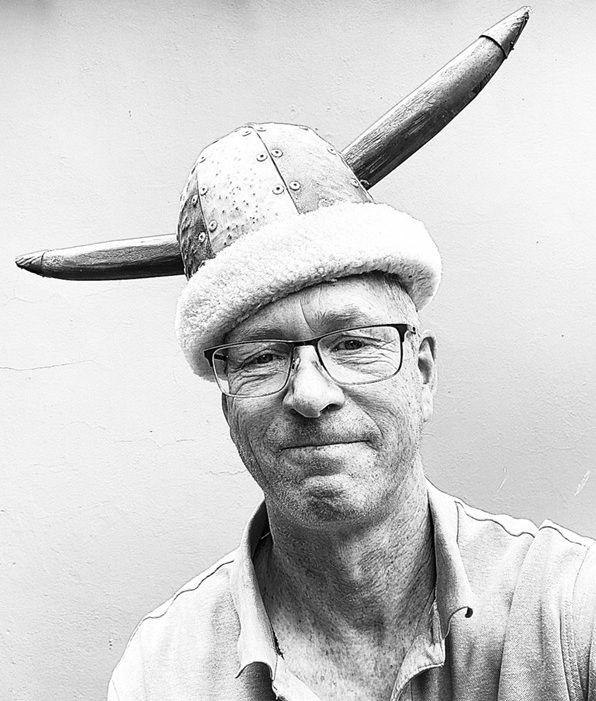
Thursday:
Imposter syndrome is that feeling you get when people think you’re an expert....but you know you’re just a numpty. I’ve met plenty of long-distance adventure bikers on my travels and they all seem like experts to me. Maybe some of them think I’m an expert after doing 25,000 miles of adventuring over the past three years and riding through more than 30 countries. But I still feel like a total numpty!
Such are my musings on a sunny morning in Helsinki as I pack my bags, load Tigger, wave goodbye to biker-chick Renata and thread my way southwards through the city to the ferry port. I turn in at the gate, show my ticket to the girl in the ticket booth, ride over to lane number 9, forget to put Tigger’s side-stand down and topple him over in an ignominious heap on the tarmac. See. Numpty….!

Anyway. This ferry. The one from Helsinki to Tallinn. It is possibly the craziest ferry I’ve been on yet. First, it is heaving with people. Hundreds and hundreds of them. By the time I’ve got Tigger back shiny-side up (embarrassing) and secured him in the depths of the hold (velcro on the brake lever, leave him in gear, tie him down with the ratchet straps – you know the drill) and have made my way up to the passenger deck, the passenger deck is already full, shoulder to shoulder, with heavily drinking Finns. In the café, in the lounge and out on the sun-deck, tops are off, sunnies are on and beer is sloshing everywhere. And we haven’t left Helsinki yet! I squeeze through, find a small space to squat on the floor on one of the outside decks and try to keep clear of the mayhem. Second, there’s a busy sauna on this ferry (of course there is, it’s Finland!) with people in various states of undress staggering in and out. Third, there’s a DJ. Honestly. The Finns like to call themselves introverts. I beg to differ.
Two noisy, boozy, steamy, hours later we’ve arrived in Estonia. My hostel for the night is a whopping 7km out from the centre of Tallinn. Why? Well, when I looked for accommodation here I found it was all either fully booked or ridiculously expensive. I mean €250 a night for a bed in a shabby hostel? C’mon! That’s crazy. Everywhere else I’ve been on this tour a hostel costs a tenth of that price.
The ferry drops us right in the centre of Tallinn. It takes me about twenty minutes to ride out of town as far as the Freedom65 Hostel. Here I have successfully booked a bunk in an 8-bed dorm for €30. The dorm – let’s describe it as ‘low-budget’ and say no more about it - is fully occupied tonight, and so are all the beds in all the other rooms. What’s going on in Tallinn? In the bunk next to mine is an Australian girl, Jessie. She’s a PE teacher. She says she makes a living trying to keep kids fit in the International School in Dubai. She’s the first native English speaker I’ve met since I was in Fredrikstad three weeks ago. ‘Oh’, she says, ‘I’ve just found out that AC/DC are playing a gig in Tallinn tonight’. Ah. So that explains it. The crowded ferry, the over-priced accommodation, all the AC/DC t-shirts… and later on, the noise of heavy rock music wafting gently over the hostel’s sorry-looking garden. I tell Jessie that I was at an AC/DC festival in Kirriemuir a short while ago, Bon Scot’s birthplace. ‘I thought he was Australian’ she says. Honestly, the youth of today!
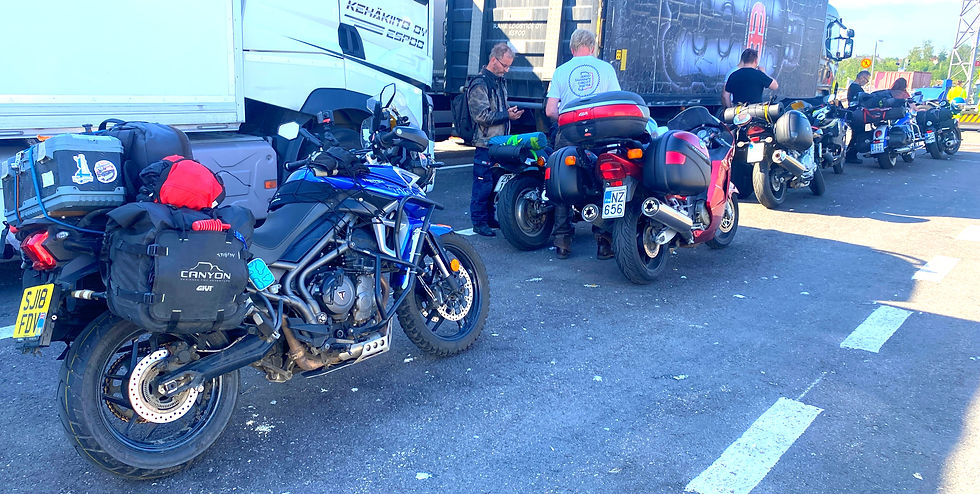
Jessie is a fully modern Gen Z solo-globetrotter. ‘I just use Googlemaps to find buses and trains. You can go anywhere like that’ she says. She’s been to a lot of places that Tigger and I have also been to such as Krakow in Poland, Brasov in Romania and Esssouira in Morocco. She ranks places on a) how good the surfing was and b) how good the party was. Nice girl. Polar opposite to me…
Friday:
I take a leaf out of Jessie’s book, and find a bus heading into the centre of Tallinn. ‘Just get on and tap your card….’ she says. Turns out she’s right. It’s easy-peasy and Googlemaps is surprisingly accurate. Like most modern cities the outskirts of Tallinn are fairly grim, with featureless blocks of industrial units and offices (I blame the Architects) but once I reach the historic centre I start to realise what a fabulous city this is. There are small winding streets, picturesque town squares, churches, towers, spires and turrets. I climb up and walk along the medieval town walls. I visit St Catherine’s passage. I take a peek at the Kiek de Kok castle. All lovely stuff…. I sit to paint a couple of sketches (with offers from passers-by to buy both) and treat myself to a big pizza for lunch.
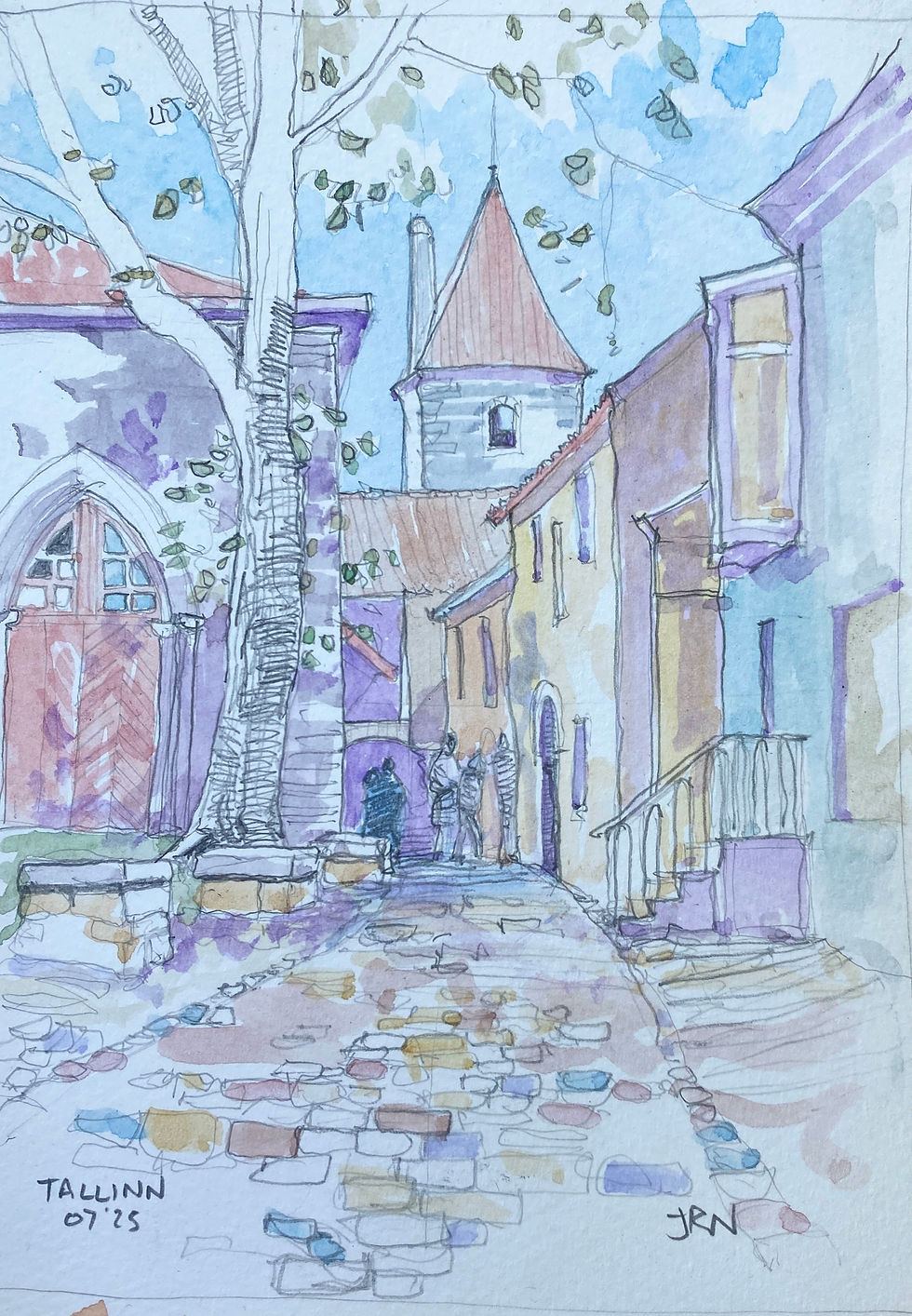
As the day progresses the streets slowly fill up with bleary-eyed AC/DC fans shuffling about like they would rather not be out in daylight. Late in the afternoon I find a bus heading back to Freedom65 and spend a comfortable evening in the hostel’s garden reading a book (Three Body Problem – highly recommend it). Not a bad day by my standards. I wish it wasn’t quite so hot, though! I’ve always associated the word ‘Baltic’ with ‘cold’, but the temperature has been in the high 20’s or low 30’s here all day. Phew. A scorcher!
Saturday:
By 08:30 Tigger and I are packed up and we’re on the road heading south. Tonight’s stop will be the city of Riga, the capital of Latvia. I’ll be going on to Vilnius later in the week, so over the next few days I’ll be following the route of the ‘Freedom Chain’, an astonishing event that took place in 1989 when two million Estonians, Latvians and Lithuanians linked hands all the way from Tallinn to Riga to Vilnius – over 400 miles - to protest against the Soviet occupation of their countries.
I have a couple of detours planned along the way today. First, I strike out into the Estonian countryside to visit the ruins of the caste at Viljandi. The landscape is flat

and the roads are straight and we’re there by mid-morning. Arriving in the centre of the town I find that the castle is off-limits today. There’s a music festival occupying the castle grounds. Road access is closed and foot access is for festival ticket holders only. Oh well, never mind. It's one to come back to another day. We press on.
Not far beyond Viljandi we reach the border with Latvia. There’s a big ‘Latvia’ sign and a convenient layby to stop in so I make the most of the photo op. Latvia is my tenth country of this tour. It didn’t take Tigger and I very long to ride across Estonia from north to south. Estonia is not a very big country!
Moving on, it's time for my second detour of the day. I plan to stop in the Latvian town of Cesis to see the castle there. The Latvian countryside is as flat and featureless as its Estonian equivalent. This is now pretty much what I’m expecting to see all the way across Poland, Germany and The Netherlands. Before long we arrive in Cesis. The hot sun is bouncing off the pavements as I park Tigger. I set off on foot to wander through the town, heading towards the castle. It’s not the perfect weather for walking about in my leathers! I feel over-heated and sweaty as I dodge between areas of shade and I can’t explore the castle as fully as I would on a cooler day. I sit to paint a sketch using the shade of a beech tree to keep me cool. While I’m sitting there’s a jazz band playing in a marquee behind me, and somewhere beyond the castle there’s an orchestra tuning up for an open-air concert later in the day. All very nice.

I stroll back to Tigger, and in the late afternoon sunshine we press on into Riga. Tonight I have a room to myself in Riga’s ‘Happy Hostel’. This one’s also a bus ride away from the old town but I’m sure I’ll cope with it. Like so many low-budget hostels there’s no café on site and no restaurants anywhere nearby. The only restaurant I can find is in the middle of hosting a wedding reception. I don’t think they’d take too kindly to a grubby biker gate-crashing it. There’s a communal kitchen in the hostel, though, and I find a supermarket not too far away, so I can cook for myself today.
Sunday:
The bus ride into Riga is fairly simple. At least it is once I’ve sorted out the complex ticketing system. I have to download the Riga Mobilly app, create an account, register a bank card, load the app with Euros and purchase two 90-minute bus passes, one for going and one for coming back. Then I have to find the right bus stop, check which bus I need and activate the pass by scanning a QR code on the bus when I get on. It’s a bit of a palaver when I’m only here for one day. It would be an uphill struggle for anyone who’s not sufficiently tech-savvy. Still, a 30-minute bus ride later and I’m strolling through Riga’s old town.

Riga is bigger than Tallinn so there’s plenty to see. I book a walking tour. The guide is Marta, a retired school teacher. She has a schedule to keep to. ‘Come along. Keep up. Pay attention…’. Yes Marta! It’s just me and a couple from New York, Jim and Margo. Thanks to Marta I can tell you that Riga was built by German merchants, making use of the navigable port on the Daugava river. It became a rich city as part of the Hanseatic League together with Lubeck, Bremen and Hamburg. In medieval times, when the city wall was built, non-Germans had to leave the city at nightfall every day. The biggest trade guild was the guild of Blackheads, a guild for unmarried merchants, named after St Maurice. The Blackhead building which dominates the main square was destroyed in WW2 but has since been faithfully reconstructed.
Marta divides buildings throughout the town into different periods: The Polish-Lithuanian empire, the Swedish Empire, the Russian Tzarist Empire, the first Latvian Independence of 1917, the post WW2 Soviet occupation and the re-establishment of independence in 1990. We pass through the ‘Swedish Gate’, walk past the Museum of Occupation, and stroll into the 1920’s Art Nouveau quarter. There are churches, spires, cobbled streets and sunny squares. Jim and Margo get a ticking off for dawdling. They might be given extra homework at this rate. I like the story about the spire on St Peter’s church. The spire was destroyed in the war and later rebuilt. At the top there’s a gold weathervane in the shape of a Cockerel. The cockerel looks small from the ground but is actually the size of a horse. Apparently the Architect celebrated ‘topping out’ the project by riding the cockerel while polishing off a bottle of wine. Health and Safety? Who needs iiiiiiiittt…..

Monday:
Another day, another new country. I pack Tigger and set off early for the 5-hour ride to Vilnius, the capital of Lithuania. The long, straight, flat roads pass through acres and acres of arable farming. Wheat I think, but maybe barley too. We cross the border from Latvia into Lithuania and I pause for the photo op. This is country number eleven of this year's tour. The weather is cooler today, thank goodness. Black clouds come and go in the sky and every now and then I’m riding through a shower of rain. We ride past several historic windmills – closed on Mondays – and stop for a coffee at a modern service station. Before long we’re on the outskirts of Vilnius.
Vilnius is the biggest of the three Baltic capitals. Garmin struggles a bit with the concrete spaghetti-junction road layout, but after a few false leads and a couple of u-turns we arrive safely at the 'Fortuna' Hostel. There’s a secure gated car park here which costs €5 for cars but after a bit of a chat with the hostel’s receptionist we agree it can be free for motorbikes. Excellent. This time the hostel is only a short walk from the historic city centre so there’s no need for me to find a bus. It’s early afternoon. I check in, make sure Tigger is secure, and set off to explore the town.
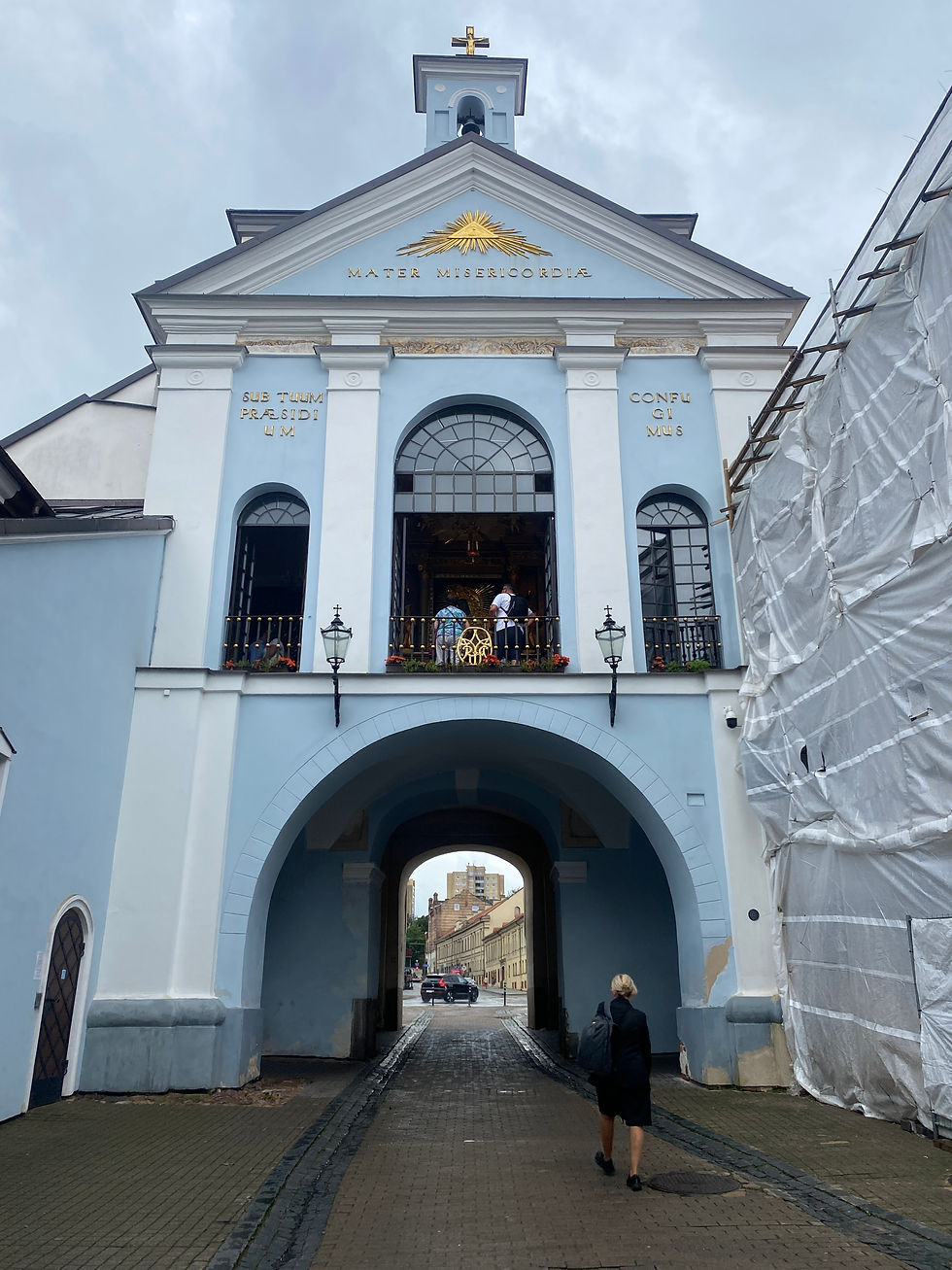
Entry into the old town is through the Gate of Dawn, built in 1503. I guess it faces east. From there I stroll down through the town marvelling at the architecture. There’s Rococo, High Baroque, Renaissance and medieval, all squished together in a happy mixture. I arrive at Vilnius Cathedral to find a full-on Classical Palladian façade. On the hill behind the cathedral is a medieval fortress - closed on Mondays - and below that is the Baroque courtyard of the Bishop’s palace. Further up the street I visit the ancient University. It is the University that really sets Vilnius apart from Riga and Tallinn. It is one of the oldest universities in the world. I sit under a Rococo colonnade to do a sketch, and poke my head into the University’s Renaissance chapel.
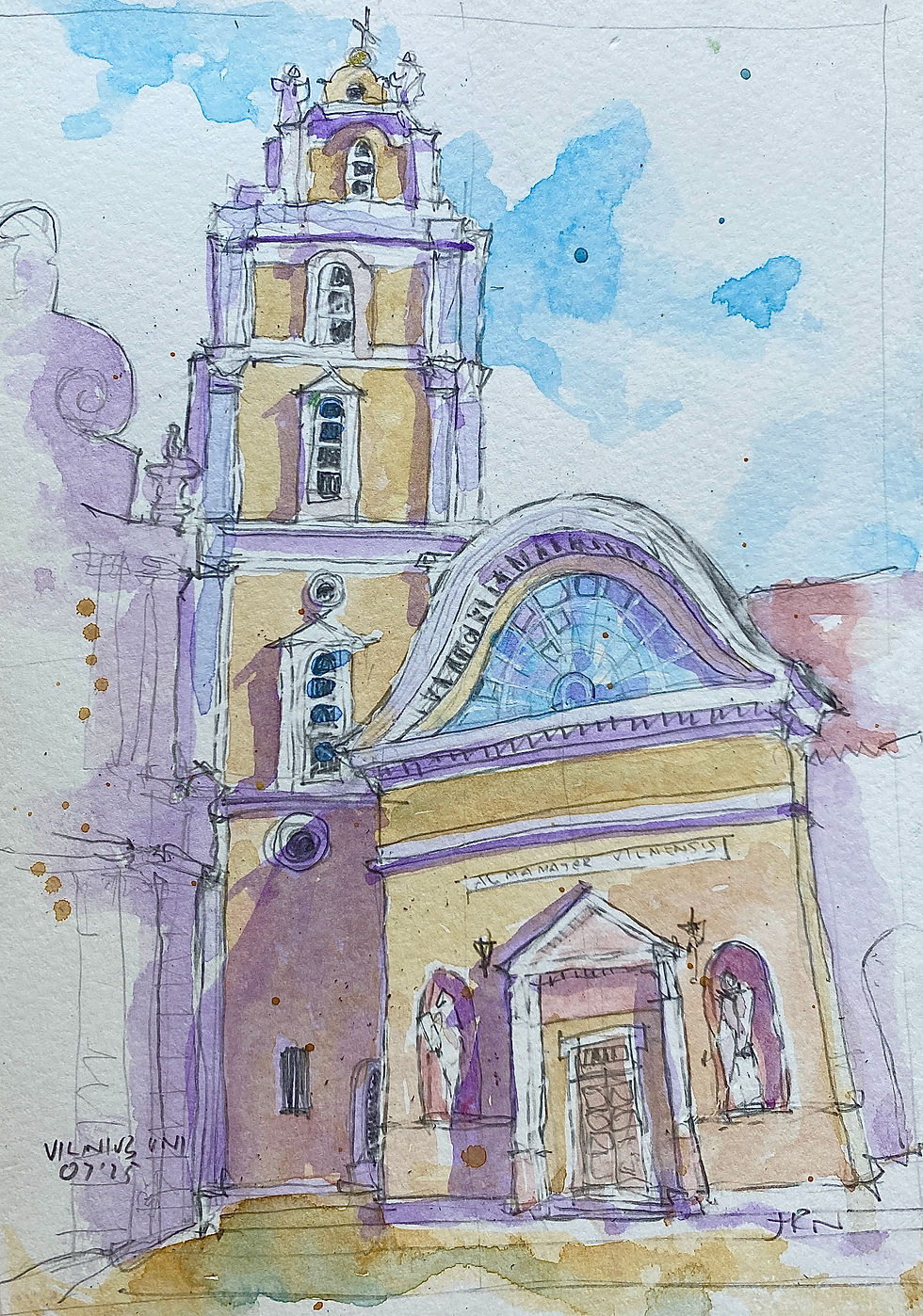
Many of the churches in Vilnius survived WW2 and were kept intact during the subsequent decades of Soviet occupation despite the communist aversion to religion. One of the churches was used as a museum of atheism. Others, including the cathedral, were used as warehouses. Most are now back to their original purpose with lost features fully restored. Sadly the same can’t be said for the town’s synagogues. At one time there were more than a hundred, and Vilnius was known as the Jerusalem of Lithuania. Today only two synagogues remain…..
By early evening I’m feeling hungry. A street café is offering traditional Lithuanian food, so I play ‘menu bingo’ and am presented with Kepta Karka, a big chunk of
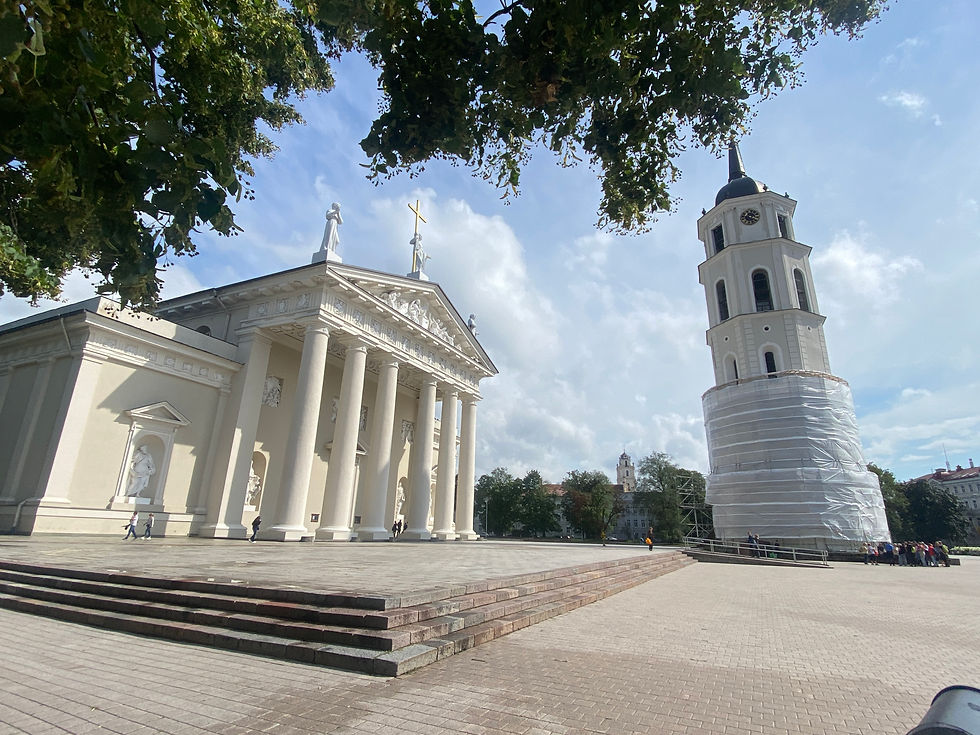
meat on the bone with sauerkraut on the side. Delicious. It’s raining again, so once I’ve eaten, I don my cagoul and scurry back to the hostel.
This hostel’s OK, but not marvellous. The mattress on my bed is so thin I can feel the bed-slatts through it. As luck would have it, I’ve got a twin room to myself so I stack one mattress on top of the other and manage to spend a comfortable night. Reminds me of the story of the Princess and the pee. Or was it pea? Probably best I don't think too hard about that.
Tuesday:
Another day another castle. After a self-made breakfast in the hostel’s kitchen I pack up, load Tigger and set off to take a look at Kaunas, one of Lithuania’s best known medieval castles. It is only an hour’s ride away from Vilnius. There’s a convenient car park near the castle so I lock Tigger up and take a walk around. What’s there is quite impressive, but most of the castle is missing! There’s only one tower, a bit of the moat (now dry and patrolled by robot lawnmowers) and a short length of an old stone wall. The castle used to be one of Lithuania’s biggest defensive structures standing at the junction of Lithuania’s two biggest rivers the Nemunas and the Neris. The problem with big rivers is that they sometimes burst their banks. In the 17th century the castle was flooded a number of times and much of the structure was washed away. What stands today is the result of restoration work carried out in 2010 and 2011. There’s an oak bridge connecting the castle to the town, and some stone steps leading down into the grassy moat. I decide to sit in the shade below the bridge to do a sketch. That done, I drop into the nearest pavement café for a coffee, then head back to the car park to retrieve Tigger.
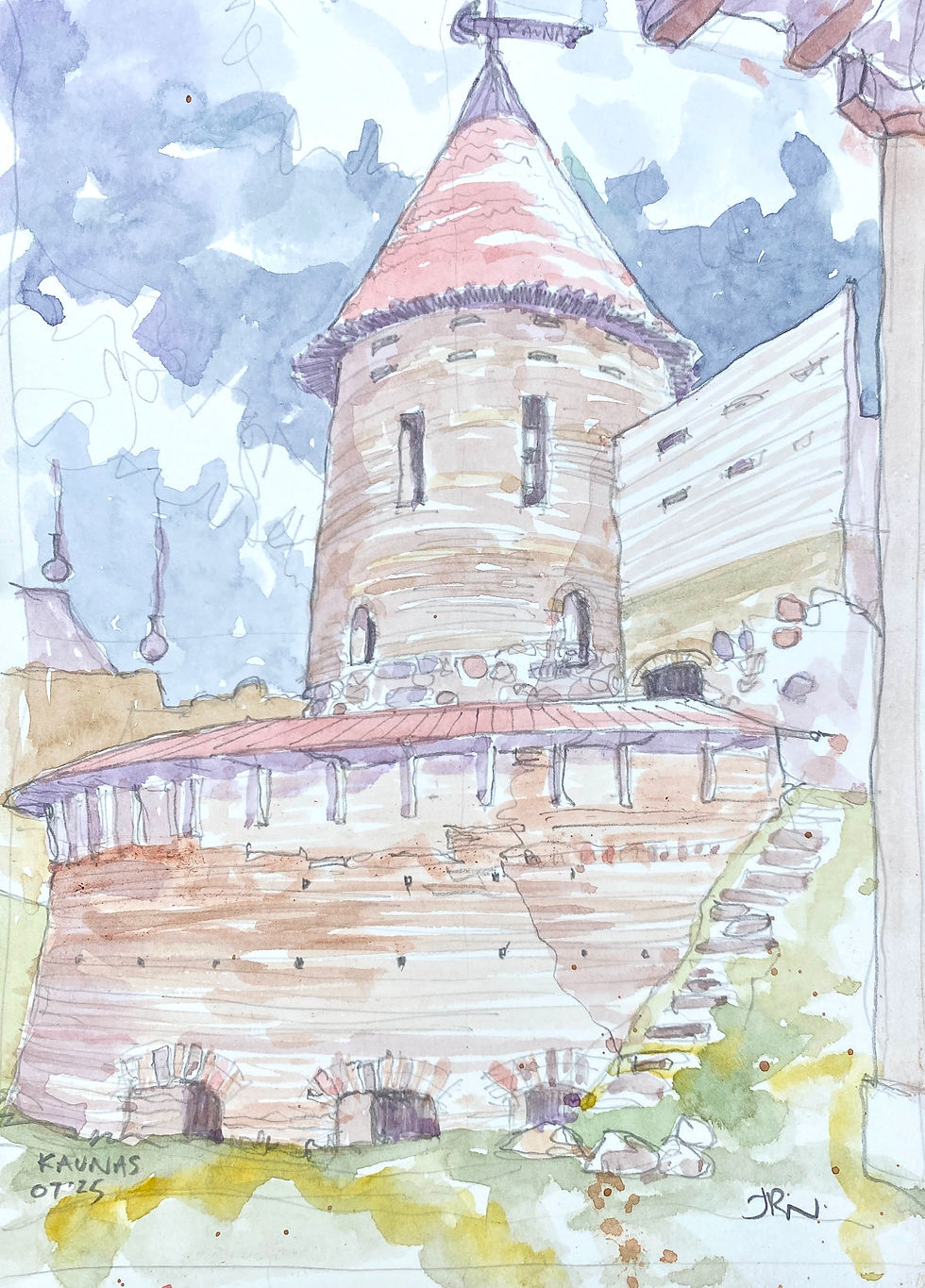
Tonight I’m being hosted by another Bunk a Biker, Danas, who lives just south of Vilnius. His house is out in the countryside surrounded by sheep, ponies and chickens. I stop at the village shop on my way past to pick up some beer to share. I can’t carry much on Tigger but I don’t like to arrive empty-handed.

Danas sees me parking outside his house and comes out with a big grin. We’re instantly swapping stories about where we’ve been on our various expeditions. It turns out that Danas has just come back from his own trip to Nordkapp riding his Africa Twin. He went the opposite way round to me, going north through Finland (using some gnarly off-road routes that were too hard-core for me) and then back south through Sweden. It took him four weeks. We discover that he stayed with some of the same people that I stayed with so we have more stories to swap with each other. I decide to pause my tee-total pledge now that I’m no longer in Scandinavia and we share a few beers. Danas has also been through Romania and into Turkey recently so there’s even more for us to talk about. Finally I learn that he makes his living as an artist, an unconventional one, making decorative carvings on animal skulls. It sounds odd but he shows me a few of his pieces. They’re very intricate and surprisingly beautiful! He sells them all over the world. Now where was that idea when I was at my school’s careers day…?

Wednesday:
Danas prepares boiled eggs for breakfast. Tigger has spent the night in the locked garage. It’s raining as I wheel him out and strap on my luggage. It is the kind of persistent rain that is destined to defeat every attempt at waterproofing. I check the weather app on my phone to see if it is worth waiting for the rain to stop but the app confirms the rain is set for most of the day. That’s the bad news. The good news is that the rain is localised on the Lithuanian side of the nearby border. On the Polish side there’s a red warning for a drought, apparently.
I pile on all my waterproof gear and set off heading west, bumping Tigger’s sump-guard on Danas’ garden path as I go. Numpty! West of Vilnius is one of Lithuania’s nicest national parks. There are small villages, little wooden cottages, winding roads and lots of lakes. Sadly all I can see is the rain and mist on my visor!
At the Polish border there are Border Guards checking people’s papers. They wave Tigger and I straight through. Hey, what do you know! The weather app was right. As we head into Poland the rain stops and a hazy sunshine tries to push its way through the clouds.

This is the part of Europe called the Sowalki gap, the narrow strip of land sandwiched between Belarus, Poland, Lithuania and Russia’s Kaliningrad. The police presence doesn’t surprise me here. In fact I’m surprised there isn’t more military on show. The fields and forests look very peaceful but right now this area is a geo-political tinderbox.
The Russian naval base of Kaliningrad is a few miles to the north. Kaliningrad is an ‘exclave’, a part of Russia that has no direct land link to the rest of Russia. It remained part of Russia when Estonia, Latvia and Lithuania became independent. As a naval base it has great significance because it is Russia’s only port that remains ice-free all year round. Lithuania’s border with Belarus is a few miles to the south. Since Kaliningrad is effectively landlocked, Russia uses the Sowalki gap to transport personnel and equipment from Belarus into Kaliningrad through Lithuania. Following Russia’s invasion of Ukraine, Lithuania threatened to cut off this supply-line because of the international sanctions placed on Russia. Russia’s reply was that cutting off this supply-line would be interpreted as an act of war!! Lithuania is a member of NATO, so that would bring NATO and Russia nose-to-nose.
So…..The Sowalki gap is important. It has the potential to become a very big deal indeed. Drones are regularly seen flying over the border from Belarus into Lithuania just to test the responses. Planes circle overhead day and night. Meanwhile, as far as I’m concerned, birds are tweeting, cattle are mooing, the sun is shining and Tigger and I can toddle along into the town of Sowalki itself.
There. We’re in Poland. Country number twelve of this tour. The Baltic states are done. It feels like I’m now on the final push towards home….
Tigger miles in 2023 = 8,02
Tigger miles in 2024 = 6,259
Tigger miles in 2025 so far = 8,168 (= 13,068 km)




Comments